 W
WAgama africana is a species of lizard in the family Agamidae. It is a small lizard found in Liberia, Ivory Coast, Guinea, and Ghana.
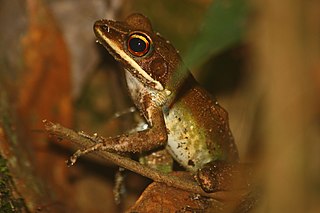 W
WAmnirana albolabris is a species of frog in the family Ranidae. It is widely distributed in Sub-Saharan West and Middle Africa. However, the nominal species includes at least one undescribed species west of Benin; the formal taxonomic changes to split the species have not yet been done. Common names white-lipped frog and forest white-lipped frog has been coined for it, whereas Bamileke Plateau frog refers to now-synonymized Amnirana longipes.
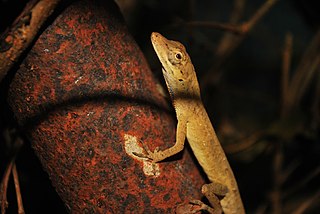 W
WAnolis sericeus, the silky anole, is a species of lizard in the family Dactyloidae. The species is found in Mexico, Guatemala, and Costa Rica.
 W
WThe arboreal salamander is a species of climbing salamander. An insectivore, it is native to California and Baja California, where it is primarily associated with oak and sycamore woodlands, and thick chaparral.
 W
WAtheris squamigera is a viper species endemic to west and central Africa. No subspecies are currently recognized. Like all vipers, the species is venomous.
 W
WThe Baja California chorus frog is a species of treefrog of Western North America. It was formerly considered as part of the Pacific chorus frog, but was split and raised to species status in 2006. The species ranges from the West Coast of the United States from Baja California through southern California. Individuals live from sea level to more than 10,000 feet in many types of habitats, reproducing in aquatic settings. It occurs in shades of greens or browns and can change colors over periods of hours and weeks.
 W
WBolitoglossinae is a subfamily of lungless salamander. Most of them are native to tropical areas in Central and South America, though a few such as Batrachoseps are found in temperate regions. Its sister group is the extinct genus Palaeoplethodon.
 W
WThe Ryukyu Kajika frog, Japanese Buerger's frog, or Japanese stream treefrog is a species of frog in the family Rhacophoridae. It is found in the Ryukyu Islands (Japan) and in Taiwan.
 W
WThe graceful chameleon is a species of chameleon native to sub-Saharan Africa. It is commonly around a foot long. Because of its abundance, it is heavily exploited by the pet trade.
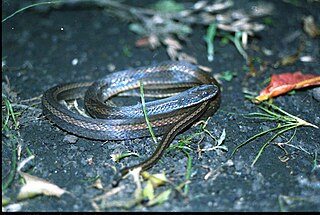 W
WConiophanes is a genus of colubrid snakes, typically referred to as black-striped snakes, but they also have many other common names. The genus consists of 17 species, and despite the common name, not all of them display striping.
 W
WThe sidewinder, also known as the horned rattlesnake and sidewinder rattlesnake, is a venomous pit viper species belonging to the genus Crotalus, and is found in the desert regions of the Southwestern United States and northwestern Mexico. Three subspecies are currently recognized.
 W
WDiploderma is a genus of lizards in the family Agamidae. Species of Diploderma are native to Myanmar, China, Vietnam, Taiwan, and Japan. Most of the species are found in China, including many endemics.
 W
WDiploderma polygonatum, also known as Ryukyu japalure and Okinawa tree lizard, is a species of lizard found in the Ryukyu Islands and Taiwan. It is diurnal and arboreal. An adult male Diploderma polygonatum measures "61 mm. from snout to vent, and 152 mm. from vent to tip of tail; total length 213 mm." The splenial of this lizard is short, as is that of Trapelus agilis. The lizard is also closely related to Diploderma swinhonis.
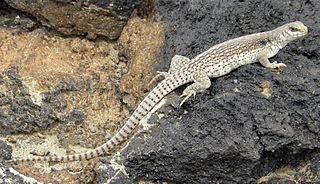 W
WDipsosaurus is a genus of lizards in the family Iguanidae.
 W
WEutropis longicaudata, the longtail mabuya or long-tailed sun skink, is a species of skink. It is found in southern China, Hong Kong, Taiwan, Laos, Vietnam, Thailand, Cambodia, and Peninsular Malaysia.
 W
WThe graceful chameleon is a species of chameleon native to sub-Saharan Africa. It is commonly around a foot long. Because of its abundance, it is heavily exploited by the pet trade.
 W
WGymnophthalmus speciosus, the golden spectacled tegu, is a microteiid lizard found in Mexico, Central America, and Colombia. It is a small, cylindrical lizard with a long tail and a tendency to reduced extremeties.
 W
WHolcosus quadrilineatus, the four-lined ameiva or four-lined whiptail, is a species of whiptail lizard found in western Panama, Costa Rica, and southeast Nicaragua.
 W
WHyperolius concolor, also known as the variable reed frog or Hallowell's sedge frog, is a species of frog in the family Hyperoliidae. It occurs in West and Middle Africa.
 W
WThe western green mamba is a long, thin, and highly venomous snake species of the mamba genus, Dendroaspis. This species was first described in 1844 by American herpetologist Edward Hallowell. The western green mamba is a fairly large and predominantly arboreal species, capable of navigating through trees swiftly and gracefully. It will also descend to ground level to pursue prey such as rodents and other small mammals.
 W
WNerodia rhombifer, commonly known as the diamondback water snake, is a species of nonvenomous natricine colubrid endemic to the central United States and northern Mexico. There are three recognized subspecies of N. rhombifer, including the nominotypical subspecies.
 W
WNinia atrata, known commonly as Hallowell's coffee snake, Hallowell's earth snake, the red-nape snake, and the South American coffee snake, is a species of small terrestrial snake in the family Colubridae. The species is native to southern Central America and northern South America.
 W
WPelophylax nigromaculatus, is a species of true frog found in East Asia, first described in 1861. This widespread and common frog has many common names, including dark-spotted frog, black-spotted pond frog, and black-spotted frog.
 W
WPituophis catenifer affinis, commonly known as the Sonoran gopher snake, is a nonvenomous subspecies of colubrid that is endemic to the southwestern United States. It is one of six recognized subspecies of the gopher snake, Pituophis catenifer.
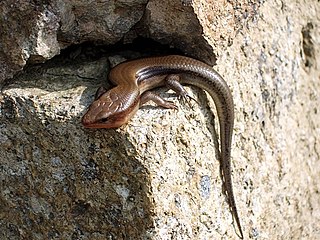 W
WThe Far Eastern skink or Japanese five-lined skink is a species of lizard which is endemic to Japan.
 W
WPlestiodon multivirgatus, commonly known as the many-lined skink, the northern many-lined skink, or the variable skink, is a medium-sized species of lizard, a member of the North American skink genus Plestiodon in the family Scincidae.
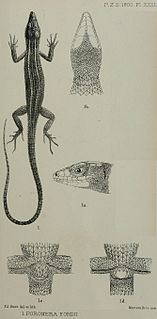 W
WPoromera is a genus of lizard in the family Lacertidae. The genus Poromera is monotypic, containing the single species, Poromera fordii, commonly known as the West African striped lizard. The species is endemic to western Central Africa.
 W
WProtobothrops flavoviridis is a species of venomous pit viper endemic to the Ryukyu Islands of Japan. No subspecies are currently recognized. Local common names include habu, Okinawa habu, and Kume Shima habu.
 W
WThe Baja California chorus frog is a species of treefrog of Western North America. It was formerly considered as part of the Pacific chorus frog, but was split and raised to species status in 2006. The species ranges from the West Coast of the United States from Baja California through southern California. Individuals live from sea level to more than 10,000 feet in many types of habitats, reproducing in aquatic settings. It occurs in shades of greens or browns and can change colors over periods of hours and weeks.
 W
WThe Ryukyu Kajika frog, Japanese Buerger's frog, or Japanese stream treefrog is a species of frog in the family Rhacophoridae. It is found in the Ryukyu Islands (Japan) and in Taiwan.
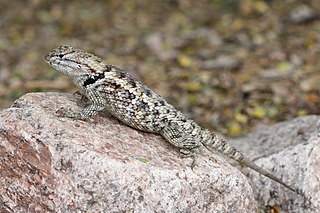 W
WSceloporus magister, also known as the desert spiny lizard, is a lizard species of the family Phrynosomatidae, native to the Chihuahuan Desert and Sonoran Desert of North America.
 W
WThe striped whipsnake is a species of nonvenomous snake in the family Colubridae. It is closely related to the California whipsnake. The striped whipsnake is native to the western United States and adjacent northern Mexico.
 W
WTrachylepis albilabris, the Guinea mabuya, is a species of skink found in Africa.
 W
WUrosaurus is a genus of lizards, commonly known as tree lizards or brush lizards, belonging to the New World family Phrynosomatidae.
 W
WThe long-tailed brush lizard, Urosaurus graciosus, is a species of lizard in the family Phrynosomatidae. The species is native to the southwestern United States and adjacent northern Mexico.